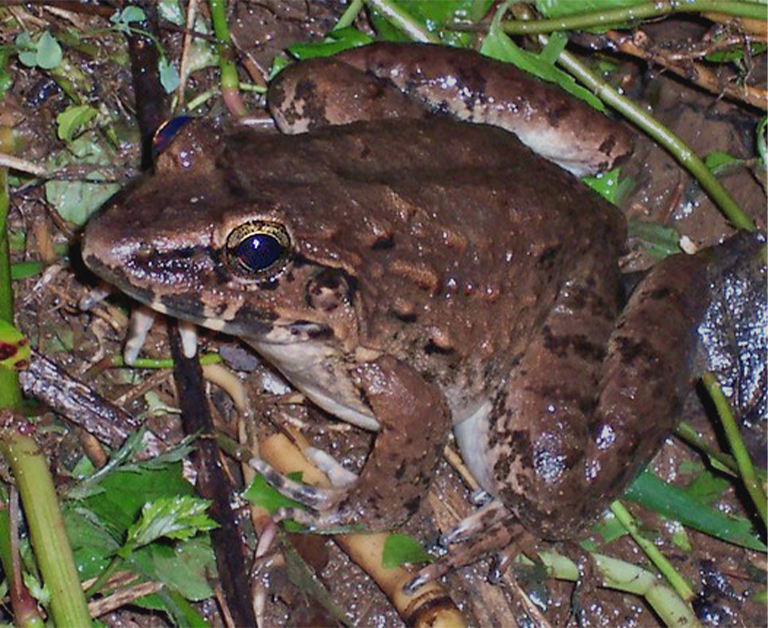- The European Union is the world’s largest consumer of frogs’ legs from wild-caught species, most of them imported from Indonesia, according to a group of conservationists and researchers.
- A lack of transparency and environmental impact assessments connected to the trade is cause for concern and is increasing the risk of local and regional extinctions, they say.
- They note the trade also poses the threat of introducing pathogens that could affect frog populations in the importing countries.
Each year, the European Union imports an estimated 4,000 metric tons of frogs’ legs. That sum is the equivalent of around 200 million frogs killed to feed demand, the majority of which are caught in the wild as part of a trade that’s unregulated and unsustainable, according to a group of conservationists and researchers.
In their recent paper, published in the journal Conservation, they underline that this trade is increasing the risk of local and regional frog extinctions in countries such as Indonesia, Vietnam, Turkey and Albania, the main source countries for the EU market.
Between 2011 and 2020, the EU imported 40,700 metric tons of frogs’ legs, equating to between 814 million and 2 billion frogs; Indonesia accounted for more than 70% of that trade. This makes the EU the largest importer of frogs’ legs originating from wild-caught species in the world.

Amid a global decline of biodiversity, this trade is likely heavily involved in reducing populations of amphibians in source countries and is linked to increasing uses of pesticides due to the loss of ecosystem services provided by wild species, according to Sandra Altherr, a biologist and co-founder of German NGO Pro Wildlife.
“Hence, the frogs’ legs trade has direct consequences not only for the frog populations themselves, but also for biodiversity and ecosystem health as a whole,” Altherr, a co-author of the new paper, told Mongabay. She described the trade as a “black box,” with little information on species traded, their origins, or the environmental impact.
This lack of transparent data is a concern, according to lead author Mark Auliya, with the Leibniz Institute for the Analysis of Biodiversity Change. “As the currently most prominent species involved in the frogs’ legs trade are not listed on CITES” — the international convention on the wildlife trade — “there is no database to accurately document the volumes, species, and countries involved in international trade,” he said.
Past research from Turkey suggests that the exploitation of large-legged species is drastically increasing risks of extinction in the near term. Equivalent studies in other locations are lacking, conservationists say.
Auliya said it’s not the “prime task” of conservationists to determine the sustainability of trade through self-funded studies: “[T]hese would have to be carried out and financed by the trader side in cooperation with experts, to assure that species’ offtakes are sustainable.”

Co-author Alice Hughes, an associate professor at Xishuangbanna Tropical Botanical Garden in southern China, said the trade’s absence of screening also poses a disease transmission concern. “There’s no biosafety regulation, meaning that things like ranavirus and chytrid fungus can wash out into the rivers and potentially infect native populations, and this is something that has been completely neglected,” she told Mongabay.
“Europeans might think that their frogs’ legs are completely sustainable and farmed,” Hughes added. “What we know is they include both farmed and wild-caught individuals of a variety of species, many of which are not widely disclosed, and many of which are likely not to be sustainably harvested.”
Conservationists are calling for urgent action to be taken to lessen these potential impacts and ensure the frogs’ leg trade is sustainable.
“We are urging the EU to start a listing initiative at CITES to ensure at least a trade is taking place with data at the species’ level, and to cross check the sustainability,” Altherr said. “There should also be awareness about the manifold problems linked to the frog’s leg trade [among consumers], not to forget the cruel killing methods.”
Banner image: A crab-eating frog (Fejervarya cancrivora), one of the frogs commonly caught for consumption. Image by Bernard DUPONT via Flickr (CC BY-SA 2.0).
Citations:
Auliya, M., Altherr, S., Hughes, A., Nithart, C., Ohler, A., & Bickford, D. (2023). The European market remains the largest consumer of frogs’ legs from wild species. Conservation, 3(1), 53-58. doi:10.3390/conservation3010004
Ohler, A., & Nicolas, V. (2017). Which frog’s legs do froggies eat? The use of DNA barcoding for identification of deep frozen frog legs (Dicroglossidae, Amphibia) commercialized in France. European Journal of Taxonomy, (271). doi:10.5852/ejt.2017.271
Çiçek, K., Ayaz, D., Afsar, M., Bayrakcı, Y., Pekşen, Ç, Cumhuriyet, O., … Akçakaya, H. (2021). Unsustainable harvest of water frogs in southern Turkey for the European market. Oryx, 55(3), 364-372. doi:10.1017/S0030605319000176
